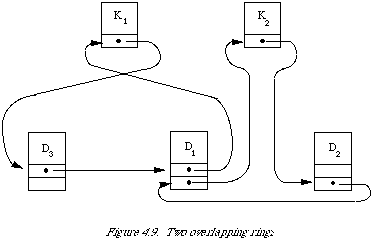|
|
79 |
|
|
|
|
level.
The field marked Ci normally contains some identifying
information with respect to the ring it subsumes.
For example,
C1 in some way identifies the class of documents {D1,
D2}.
Were we to group documents according to the keywords they shared, then for each keyword we would have a group of documents, namely, those which had that keyword in common. Ci would then be the field containing the keyword uniting that particular group. The rings would of course overlap (Figure 4.9), as in this example:
D1 = {K1, K2} D2 = {K2, K3} D3 = {K1, K4}
The usefulness of this kind of structure will become more apparent when we discuss searching of classifications. If each ring has associated with it a record which contains identifying information for its members, then, a search strategy searching a structure such as this will first look at Ci (or Ki in the second example) to determine whether to proceed or abandon the search.
Threaded lists
In this section an elementary knowledge of list processing will be assumed. Readers who are unfamiliar with this topic should consult the little book by Foster[20].
A simple list representation of the classification ((D1, D2), (D3, D4)), ((D5, D6), (D7, D8))
|
|
|
79 |
|
|
|
